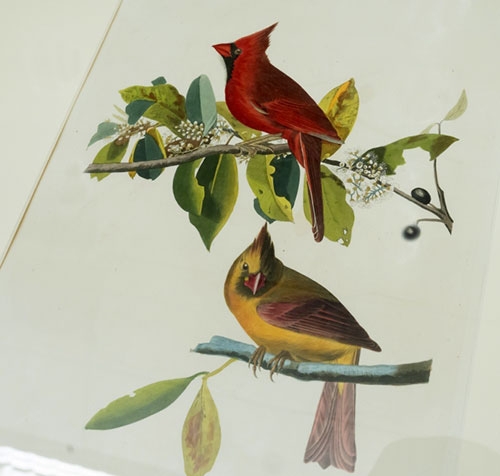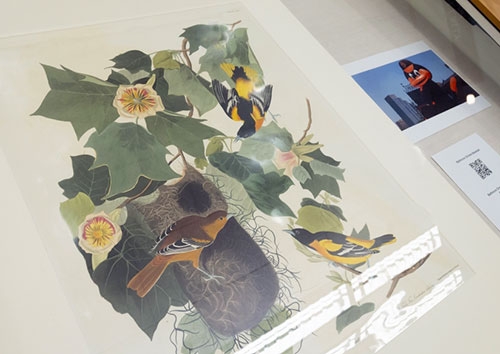Naturalist and painter John James Audubon famously drew watercolors of hundreds of species of birds for his stunning collection, “Birds of America.”
Major league baseball features several teams named after birds: the Baltimore Orioles, Toronto Blue Jays and St. Louis Cardinals. A fourth, the Washington Nationals, features as its mascot a bald eagle named Screech.
So, in an ode to the start of the baseball season, prints from Union’s set of the rare and extremely valuable “Birds of America” and images of the baseball teams with bird mascots are the lineup of a new exhibit, “Birds of Baseball,” in the Lally Reading Room in Schaffer Library.
For example, Audubon’s Baltimore Oriole (Plate 12) is matched with an image of the baseball’s team’s mascot, the Oriole Bird. The Blue Jay (Plate 102) shares space with Ace, Toronto’s mascot. Cardinal Grosbeak (Plate 159) is paired with Fredbird, the St. Louis mascot, while the Bald Eagle (Plate 31) is joined by an image of the Nationals’ Screech.
The pairings are displayed in four separate highly secure cases.
The idea for the exhibit stemmed from a conversation between Sarah Schmidt, director of Special Collections and Archives, and Anthony Pantuosco, stacks manager. The library typically rotates four of its Audubon prints for a display each term. A Baltimore Orioles fan, Schmidt envisioned a theme for this term’s offering.
“We were talking about baseball mascots and thought that would be a fun spring exhibit,” Schmidt said. “We wanted to show how Audubon portrayed each bird and how the different baseball teams chose to portray the bird. At first, I was afraid I would have to branch out to other sports since only the Orioles, Blue Jays and Cardinals came to mind. We needed a fourth image, and happily the Washington Nationals use the bald eagle as their mascot.
The exhibit is also a way to showcase Union’s original set of “Birds of America.” Measuring over three feet in height and running to four volumes that each weigh more than 40 pounds, “Birds of America” is one of the most celebrated books of natural history. Each set represents Audubon's efforts to find and illustrate every bird in North America.
Audubon had created about 200 copies of the set, which featured 435 hand-colored prints of 1,037 birds; only 120 sets exist today. Union President Eliphalet Nott paid Audubon $1,000 for a set in 1844. In 2018, an original set sold at an auction in New York for nearly $10 million. Except for a brief stay in baseball’s mecca, Cooperstown, N.Y., for safekeeping during World War II, Union’s prints have remained on campus as one of the College’s greatest treasures.
Union’s set was the subject of a daring theft in June 1971 which generated headlines across the country. It also drew the attention of the FBI, which helped recover the prints several weeks later in a case that remains an enduring mystery more than five decades later.
Union, like most institutions in possession of an original set, often displays for public viewing its “Birds of America.” Whereas others are limited to a page or two at a time because the four volumes are bound, Union faces no such restrictions.
As part of a restoration project the College undertook in 2006, each lithograph was removed from the College’s four bound volumes, cleaned, mended and placed in special archival boxes.
That gives the College flexibility to showcase individual plates as needed.
“This makes our set quite unusual,” Schmidt said. “It allows us to show any print side-by-side with any other print. To see the four prints in the baseball exhibit this way offers a unique Audubon viewing opportunity.”

